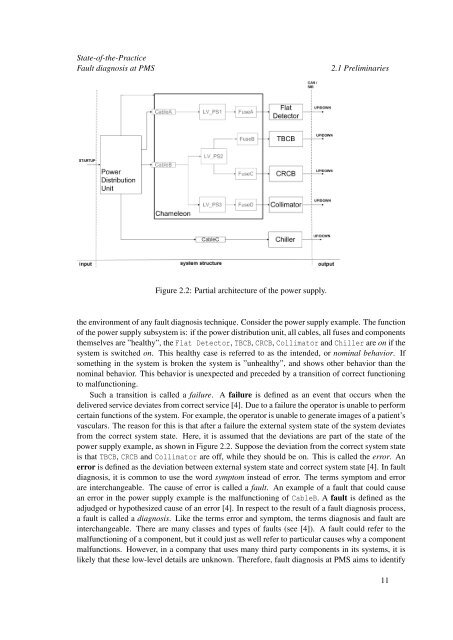pdf download - Software and Computer Technology - TU Delft
pdf download - Software and Computer Technology - TU Delft
pdf download - Software and Computer Technology - TU Delft
Create successful ePaper yourself
Turn your PDF publications into a flip-book with our unique Google optimized e-Paper software.
State-of-the-Practice<br />
Fault diagnosis at PMS<br />
2.1 Preliminaries<br />
Figure 2.2: Partial architecture of the power supply.<br />
the environment of any fault diagnosis technique. Consider the power supply example. The function<br />
of the power supply subsystem is: if the power distribution unit, all cables, all fuses <strong>and</strong> components<br />
themselves are ”healthy”, the Flat Detector, TBCB, CRCB, Collimator <strong>and</strong> Chiller are on if the<br />
system is switched on. This healthy case is referred to as the intended, or nominal behavior. If<br />
something in the system is broken the system is ”unhealthy”, <strong>and</strong> shows other behavior than the<br />
nominal behavior. This behavior is unexpected <strong>and</strong> preceded by a transition of correct functioning<br />
to malfunctioning.<br />
Such a transition is called a failure. A failure is defined as an event that occurs when the<br />
delivered service deviates from correct service [4]. Due to a failure the operator is unable to perform<br />
certain functions of the system. For example, the operator is unable to generate images of a patient’s<br />
vasculars. The reason for this is that after a failure the external system state of the system deviates<br />
from the correct system state. Here, it is assumed that the deviations are part of the state of the<br />
power supply example, as shown in Figure 2.2. Suppose the deviation from the correct system state<br />
is that TBCB, CRCB <strong>and</strong> Collimator are off, while they should be on. This is called the error. An<br />
error is defined as the deviation between external system state <strong>and</strong> correct system state [4]. In fault<br />
diagnosis, it is common to use the word symptom instead of error. The terms symptom <strong>and</strong> error<br />
are interchangeable. The cause of error is called a fault. An example of a fault that could cause<br />
an error in the power supply example is the malfunctioning of CableB. A fault is defined as the<br />
adjudged or hypothesized cause of an error [4]. In respect to the result of a fault diagnosis process,<br />
a fault is called a diagnosis. Like the terms error <strong>and</strong> symptom, the terms diagnosis <strong>and</strong> fault are<br />
interchangeable. There are many classes <strong>and</strong> types of faults (see [4]). A fault could refer to the<br />
malfunctioning of a component, but it could just as well refer to particular causes why a component<br />
malfunctions. However, in a company that uses many third party components in its systems, it is<br />
likely that these low-level details are unknown. Therefore, fault diagnosis at PMS aims to identify<br />
11
















